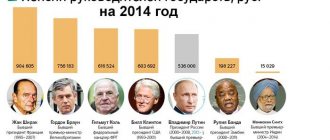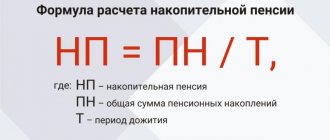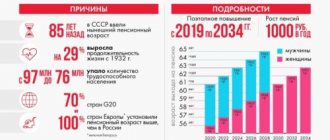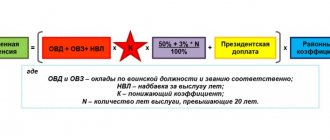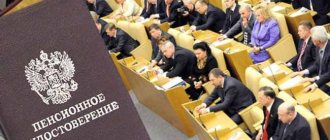Since the beginning of the 2000s, government bodies of the Russian state have been carrying out a number of organizational, legal, economic and political measures related to changes in the procedure for pension provision.
Until the adoption of innovations, the accrual of preferences took place according to a specifically developed scheme: persons of retirement age received funds from tax sources that were paid by organizations on behalf of their workers. Such a system would be able to work in a stable manner if there were 5-6 workers per pensioner, and the rate of the single social tax paid by the employer did not change.
However, taking into account demographic statistics in the country, the state decided to change the course of pension policy. In accordance with today's realities, for every ten pensioners there are only sixteen workers, which is unacceptable and can cause devastation of state extra-budgetary funds. The new principles for constructing the pension system, implemented in the Russian Federation in 2002, are designed to correct the crisis state of affairs.
Basic pension
Concept of pension parts
During the reform process, the first wave of which took place until 2015, it was established that government payments to current pensioners would consist of three parts:
- Basic.
- Insurance.
- Cumulative.
The general basis of regular monthly income is its basic element. It is understood as a material amount that is intended for all persons who have reached the established retirement age and have a minimum work experience of a total of five years.
The basic pension for the subject of pension legal relations is fixed at the federal level at a single rate and is subject to indexation every year. The payment of the basic part of the labor pension is financed from the federal budget from the amounts of the unified social tax received by it.
The insurance part is based on the length of working periods and the amount of wages of a citizen during the period of his labor function.
Components of a labor pension
On behalf of each worker, the employer sends monthly contributions to the pension fund. It is these contributions that become the numerical value for the future determination of the insured share of pension payments.
Reference! The amount of insurance payments is calculated based on a simple formula, according to which the entire total of monetary contributions to the pension fund is divided by 19 (the average life expectancy of a citizen who has reached retirement age) and multiplied by the standard duration of the insurance period. This position is reflected in.
Calculation of insurance pension
The funded part refers to the material assets of compulsory pension savings, which are managed by professional market participants, in the interests of a person who will qualify for pension provision in the future.
How does the basic pension differ from the insurance and funded pension?
Since all these 3 elements (basic, insurance, savings) form the future basis of the monthly payments due, they have much in common in their content.
However, there are signs by which one can distinguish the components of pension provision.
- First of all, the insurance element of preferences directly depends on the person’s salary. The higher the established monetary rate, the greater the volume of deductions that goes to extra-budgetary state funds. This means that the final level of pension will differ significantly in size. While the basic part has no relationship with how much money a citizen received at his place of work before retirement. The base is expressed in clearly fixed dimensions.
- According to pension legislation, the basic part of the salary must be paid to employees immediately after reaching a specified age. A pensioner can receive the insurance component in full or in part, or may refuse to receive it altogether.
- The funded element of pension provision has similar distinctive features from the basic value, as does the insurance part.
Where does pension funding come from?
For the most detailed analysis, it is necessary to consider those aspects by which the insurance and savings parts are differentiated from each other, in isolation from the value of the base component.
Insurance part
If we talk about how the pension is calculated, then it is necessary to consider the insurance part. It differs significantly from the basic one in that it is tied to a specific person. Its size is directly dependent on the amount of contributions accumulated at that time, as well as on the period of expected payments. Each employer is required to make contributions, the amount of which amounts to 8-14% of the amount taxed for an individual employee. This amount usually includes not only wages, but also other funds that the company spends on each employee individually.
How is the basic part of the labor pension recalculated?
Recalculation of pension indicators refers to actions through which, on the basis of an application from an authorized citizen, a change in the amount of the monthly compensation payment is made.
The legislation established four grounds when pension preferences may be subject to differentiated revision:
- A pensioner reaches the age of eighty.
- Transformation of the degree of limitation of the ability to work, both upward and downward.
- Change in the number of family members with limited working ability.
- Transformation of the category of recipient of labor compensation in the event of the loss of a breadwinner.
A revision of the value of the basic element of a labor pension in connection with a citizen reaching the age of eighty years is carried out from the day this subject reaches the designated age.
In other cases, recalculation is carried out from the first day of the month after which the subject’s application was received to revise the fixed amount of the pension upward.
Reasons for recalculating the basic part of the pension
Fixed payment
The concept of a fixed payment, like many other innovations, came to the Russian legal system in 2020. It refers to a specifically established figure, fixed at the legislative level, which is intended to be paid to a citizen who has reached retirement age.
It is worth noting that this terminology has come to replace the old-established definition of the basic part of the pension. Although the essence of the concepts, as well as the procedure for assigning payments, are similar to amazing accuracy.
The following persons have the right to receive this compensation:
- Citizens applying for pension benefits due to reaching a specifically established age.
- Citizens applying for pension benefits due to bodily dysfunctions that lead to disability.
- Citizens applying for pensions due to the loss of a breadwinner.
The final amount of the benefit depends on which classification group the recipient belongs to. The amount of money previously allocated to state funds does not affect the size of the fixed part of the preference.
Video - Savings and insurance part of pension
Requirements for recipients of fixed payments
Based on the current state of affairs, we can conclude that declaring monthly social payments later than the generally established retirement age is the most profitable from an economic point of view. For each annual period of later application, the insurance pension and fixed payment are increased by the corresponding coefficients.
However, in order to become eligible for two types of these compensations, you must initially meet a number of criteria in 2020:
- Cross the line of a certain age. For males it is sixty years, for the female half of the population it is fifty-five years.
- Have at least nine years of official work experience (as of 2019).
- Have 13.8 pension points (as of 2019). They are added based on salary.
In the near future, these requirements will be tightened. By 2025 it will take fifteen years and thirty points.
Estimated changes by 2025
Above we discussed the classic characteristics of persons who carried out labor activities on a general basis.
But there are also less socially protected segments of the population for whom privileged conditions are established:
- Citizens who have worked in areas with unfavorable climatic conditions for at least fifteen years are entitled to receive fixed payments regardless of age and points.
- For disabled people, the basic pension amount is established after a medical and social examination makes a decision on assigning a disability group.
- Dependents who have lost their breadwinner are entitled to a fixed payment from the day of the loss of the family breadwinner.
Also important is the fact that, depending on the capabilities of regional budgets, citizens may be assigned additional basic values. For example, a regional fixed payment for a dependent. All these preferences are subject to joint summation.
Pension formation
Composition of pension
If we consider the question of how a pension is calculated, then it should be mentioned that it consists not only of a mandatory part, but can also be supplemented by a voluntary part, and this indicates the possibility of taking advantage of savings placed in a non-state pension fund. Mandatory pension has several types, which can be called: classic for old age, labor for disability, as well as payments associated with the loss of a breadwinner. The first of them usually includes three components: basic, funded and insurance.
Fixed basic amount of old-age labor pension in 2020
The introduction of clearly fixed values has become one of the social guarantees of providing Russians with a minimum amount of compensation payments.
As of 2020, the basic portion for a worker who left his position due to reaching retirement age is 4,983.27 thousand rubles. From the analysis it follows that this amount in 2002 was 550 rubles per month. The positive fact of annual indexation of payments and their compliance with the minimum subsistence level is noted.
The described compensatory share of state preferences falls into the category of mandatory for all citizens of retirement age with more than five years of work experience.
Thus, after working for a period of average duration, it is possible to secure a certain amount of government compensation.
How to calculate the amount of an insurance pension
Increase factor for late retirement
From modern statistical indicators it follows that Russians rarely delay the appointment of monthly payments, because the average life expectancy is not so high - 65.9 years for men and 76.7 years for women.
For each year of the latest application to state pension preferences, bonus coefficients are established:
- When applying for an insurance pension one year later, the fixed payment coefficient increases by 1.07.
- When applying for an insurance pension two years later, the fixed payment coefficient increases by 1.15.
- When applying for an insurance pension three years later, the fixed payment coefficient increases by 1.24.
- When applying for an insurance pension four years later, the fixed payment coefficient increases by 1.34.
- When applying for an insurance pension five years later, the fixed payment coefficient increases by 1.45.
Bonus coefficient table
This progression cannot continue indefinitely and its maximum score will be 2.11 - for people of retirement age performing a labor function.
The maximum score is no more than 3 - for persons of retirement age who perform a labor function and do not have a funded part of their pension.
Based on the above, we will formulate the advantages and disadvantages of late retirement:
- In case of delayed retirement, the final volume of fixed payments will increase by an increasing factor (+).
- While the subject of pension legal relations is working, the employer sends deductions of insurance contributions to state extra-budgetary funds for him and, consequently, the amount of insurance payment increases (+).
- The indexation of pension benefits for pensioners who continue to work has been canceled since 2016 (-).
- Low average life expectancy of the Russian population (-).
Thus, late retirement has both disadvantages and advantages. Each pensioner should proceed from the current individual situation.
Video - What is an insurance and funded pension?
How is the insurance portion calculated?
The insurance part of the pension is determined depending on the amount of pension capital accumulated in the citizen’s personal account and the period of survival, that is, the time determined by the state as allocated for citizens after retirement. It turns out that the insurance part of the pension is the entire pension capital divided by the survival period in months. This is exactly the size of the monthly payments. After retirement, the life expectancy is 19 years, which is usually quite enough. This period is used only to calculate the pension, and if someone lives longer, they will not be left without security. If we talk about how the old-age pension is calculated, the law establishes that the later a citizen retires after reaching the required age, the shorter his survival period will be, that is, the amount of payments will be greater.

What to do if there are reasons to increase your pension?
The bodies of the pension system of the Russian Federation carry out an annual recalculation of mandatory payments based on the reasons for their increase. This privilege can be exercised in two ways:
- Increasing your insurance pension without an application. In these cases, the territorial administration of the Pension Fund increases the individual pension coefficient of the worker from August 1 of each year. Thus, under these circumstances, the interested party does not need to take any action. In most situations, the competent authorities themselves must identify the reasons for increasing monthly payments and establish them.
- The application form for increasing the fixed amount of pension benefits is reflected in the following cases:
- the appearance of disabled dependents for a citizen of retirement age. The number of no more than three people will be taken into account. Such people must be on long-term or permanent financial support from a pensioner;
- stay in territories north of the Arctic Circle and areas similar to these areas. The increase in pension payments will occur in accordance with regional coefficients for the entire period of residence in the above-described zones;
- the occurrence of the required calendar work experience in the regions of the Far North and areas similar to these areas.
How is the pension amount calculated?
During the application procedure, the interested entity will need to fill out a form to the Administrative Regulations, a sample of which is contained on the official website of the Pension Fund.
The application shall indicate:
- Passport data (series, number, who issued it, date and place of birth, etc.).
- Addresses of actual location and place of registration.
- Phone number.
- Insurance number of an individual personal account.
- Information about citizenship.
If the stated requirements are met, the increase in pension benefits will occur from the first day of the month following the calendar month in which the above-described application was considered.
General concept
Every citizen has every right to rest, especially when it comes to well-deserved retirement. This can be understood as follows: work at a certain enterprise, to which a citizen’s entire working life has been devoted, must guarantee him financial support during the rest period. And here no one talks about the enterprise’s obligations to its former employee in terms of providing such payments. This is done by pension funds, where contributions are made by each employer throughout the employee’s entire working life. The procedure for the formation, accrual and payment of pensions on the territory of the Russian Federation is carried out in full accordance with the law “On Labor Pensions”.


